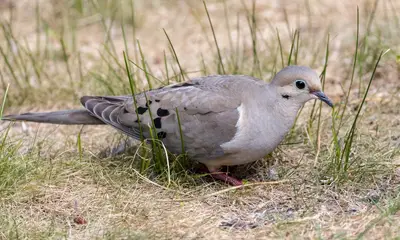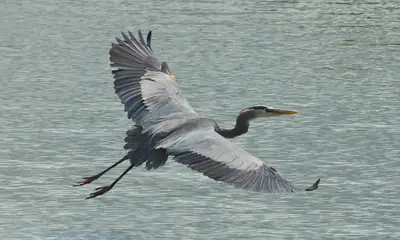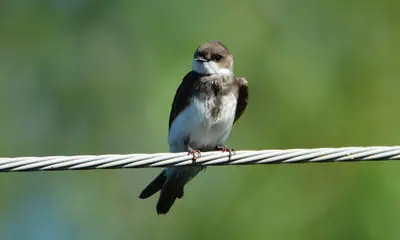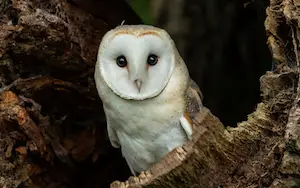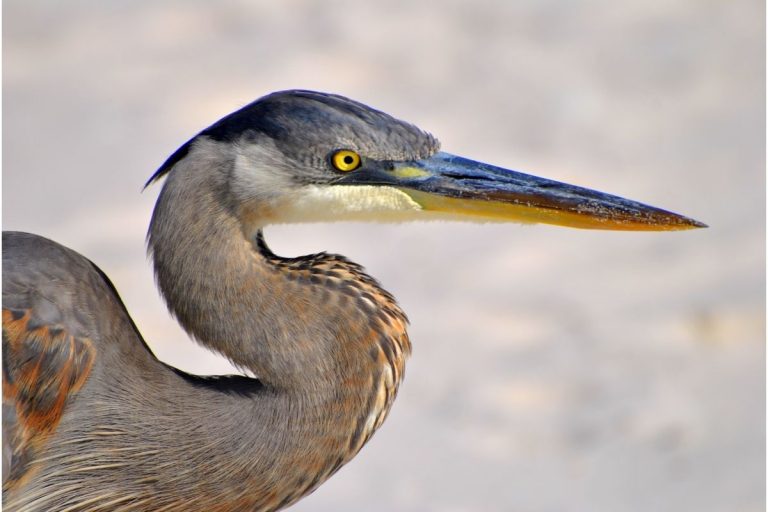9 Types of BLACK And WHITE Hawks (ID Guide With Photos)
Did you recently come across a black and white colored hawk, and want to know what species it was?
Identifying hawks with black-and-white coloration is not as easy as it might seem, since there are surprisingly many raptors in North America that fit this description.
To help you identify the bird you saw, we’ll cover the most common black and white hawks in North America in this article (plus one from South America).
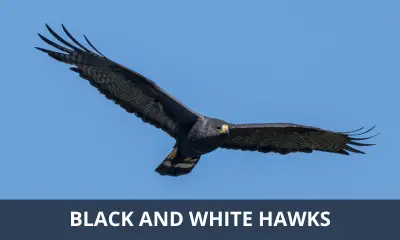
What types of hawks are black and white?
There are 9 types of hawks in North America that are black and white, and these are described in full detail below.
Let’s dive into the details, and take a closer look at each of these black-and-white colored raptors:
Zone-tailed Hawk
Scientific name: Buteo albonotatus
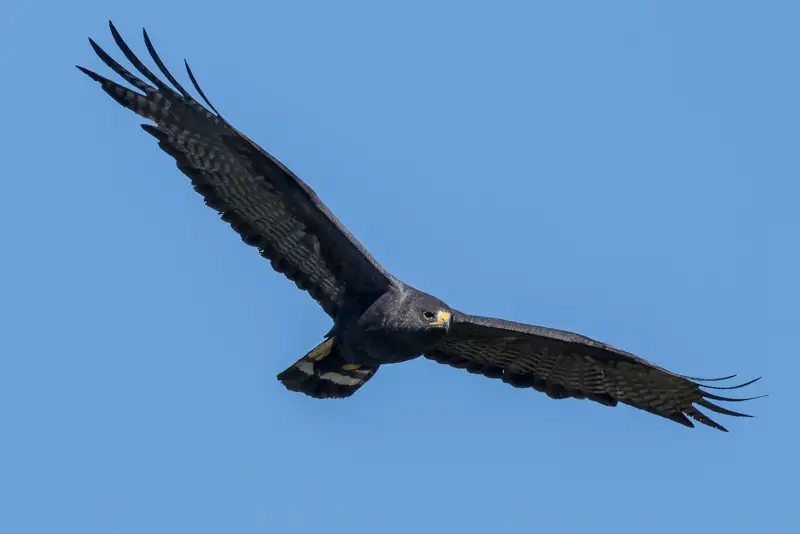
The Zone-tailed Hawk is a migratory bird of prey found in the southern United States during its breeding season in summer.
These raptors are almost entirely black, except for a bright white band on their tails.
When viewed up close, it becomes apparent that there are actually several stripes on the tail of this hawk, but from a distance, only the prominent first band is visible.
Interestingly, these birds of prey resemble Turkey Vultures both in their overall appearance and in their behavior.
Ornithologists believe that this similarity is not accidental, and that Zone-tailed Hawks use it to their advantage, as most of their prey species see Turkey Vultures as harmless birds.
They favor arid cliffs, canyons and foothills, where they hunt small mammals, reptiles and birds.
Common Black Hawk
Scientific name: Buteogallus anthracinus
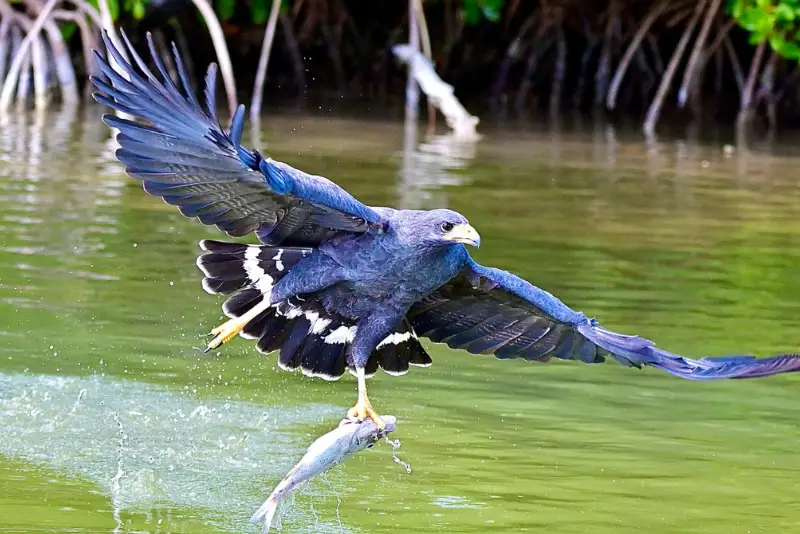
This is a large hawk with broad wings and a relatively short tail. It is best identified by its soot black color which contrasts with a single white band on its tail.
Common Black Hawks are most commonly found in Mexico and Central America, but also have a breeding population in southern Arizona.
They frequent canyons with wooded streams, where they primarily hunt fish, amphibians, and rodents that live in and around water.
These black and white raptors migrate south in September, to spend the winter in Mexico and Central America, where they are most often found in swamps and marshy areas.
Harris’s Hawk
Scientific name: Parabuteo unicinctus
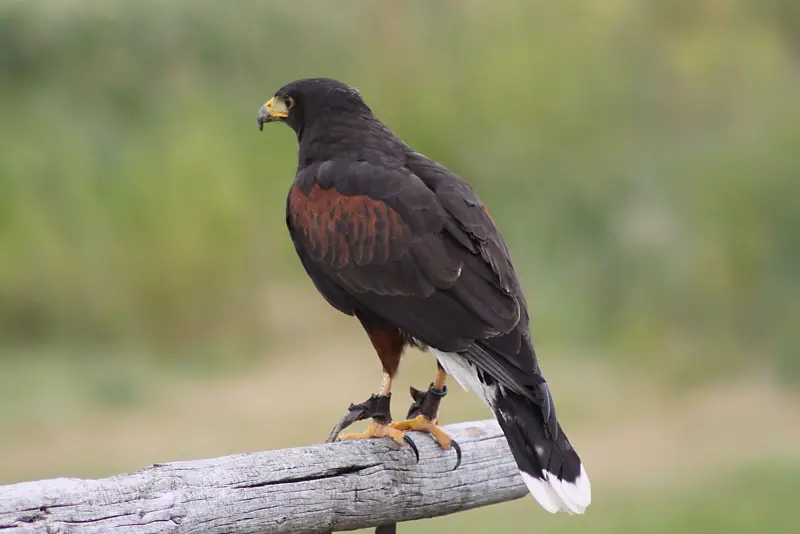
This is a large raptor species with a long tail and long legs. It is a dark brown to blackish raptor with chestnut patches on its shoulders and thighs.
Another great distinguishing feature of the Harris’s Hawk is the white terminal band at the end of the black tail, which is clearly visible when it soars on thermal currents.
These Hawks are most commonly found in Mexico and South America, but also breed in a handful of southern states, including Texas and Arizona.
Unlike most raptor species, the Harris’s Hawk is very social, and often hunts in groups of 3 or more individuals.
Scientists have found that cooperatively hunting birds are more successful than those that hunt alone.
Rough-legged Hawk (dark morph)
Scientific name: Buteo lagopus
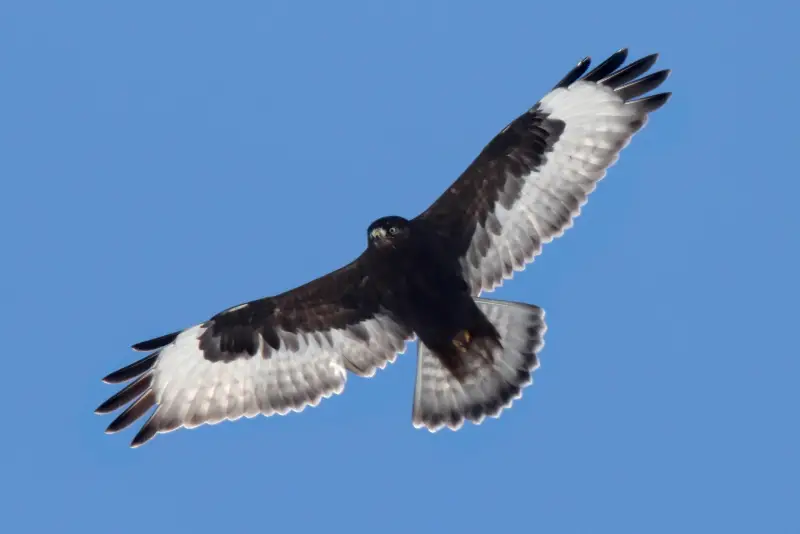
The Rough-legged Hawk is a breeding bird of the arctic tundra in northern Canada and Alaska, but can be seen wintering in large parts of the USA during the cold months.
The most common form of this buteo species is its light morph (which is characterized by large areas of white both on its upper side and underside).
However, the dark morph of the Rough-legged Hawk is also quite common, and this form is characterized by a uniformly dark brownish black body, which contrasts with its white wing feathers and base of the tail.
It can be seen in the United States from October through March, and favors open habitats such as farmland, pastures and marshland.
Its preferred foraging tactic is to hunt from a perch, such as a fence post or telephone pole, although it also hovers on occasion, similar to a kestrel.
Swainson’s Hawk (dark morph)
Scientific name: Buteo swainsoni

The Swainson’s Hawk is a compact buteo species that frequents dry prairies and open areas in western North America.
They have long, narrow wings, and the dark morph of this raptor is characterized by a uniformly dark blackish coloration, contrasting with grayish white areas on its wing undersides and tail.
In fall, these birds gather in flocks numbering in the tens of thousands that migrate south together, often together with other birds of prey, such as Broad-winged Hawks.
They are summer visitors throughout the western half of North America, where they can be seen from April through September.
Swainson’s Hawks are strictly migratory birds that spend the winter in Argentina.
Ferruginous Hawk (dark morph)
Scientific name: Buteo regalis
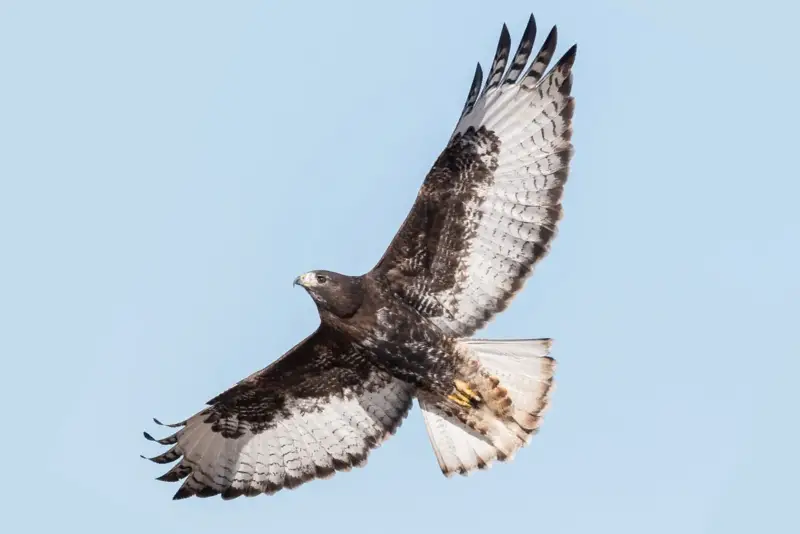
The Ferruginous Hawk is a very large buteo of the western prairies and deserts. With a wingspan of up to 56 inches, it is the largest buteo species in North America.
It occurs in two color morphs (light and dark), of which the more common is the light morph, which looks like a white bellied hawk with a gray head and rusty brown upperparts.
The dark morph, on the other hand, has a blackish brown body as well as white flight feathers with a dark band at the margin. When viewed from below, it looks like an entirely black and white bird of prey.
This hawk is a breeding bird in northern parts of the western United States, and is a winter bird in southwestern states outside of the breeding season, and also winters in Central America.
It feeds on rodents and other small mammals, with prairie dogs forming a large part of its diet.
Harlan’s Red-tailed Hawk
Scientific name: Buteo jamaicensis harlani
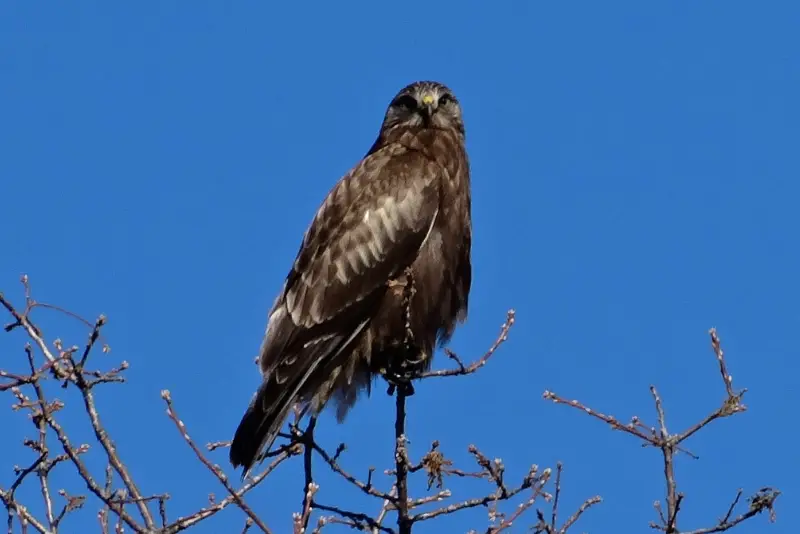
The Harlan’s Hawk is a subspecies of the Red-tailed Hawk (Buteo jamaicensis) that breeds in Alaska and northwestern Canada.
Almost the entire body of Harlan’s Red-tailed Hawks is black, contrasting with the silvery white base of their tail and the white primaries and secondaries of their wings. This combination makes them look entirely black and white when viewed from below in flight.
These raptors are winter visitors in the central United States, with most individuals wintering in Kansas and Nebraska, and some wintering as far south as northern Texas and Louisiana.
This large hawk feeds on rodents and other small animals that it catches by swooping down from its perch when they venture out into the open.
Swallow-tailed Kite
Scientific name: Elanoides forficatus

This elegant raptor is easy to identify in flight, due to the combination of its black and white coloration with a deeply forked tail.
The rear margins of the wings and the tail are black. When perched on a tree, its white head and chest contrast with the dark grayish black upperside.
Similar to other kites, this elegant raptor is a skilled hunter and capable of catching insects in flight. Its preferred food are small reptiles, rodents, and insects.
This black and white kite is a summer visitor in southeastern North America, and migrates to Central and South America to spend the winter.
The largest population of breeding Swallow-tailed Kites is currently found in Florida, but it also breeds in other southern states.
Osprey
Scientific name: Pandion haliaetus

While the Osprey is technically not a hawk, it resembles a very large hawk with a wingspan of up to 69 in (5.5 ft).
It is usually easy to identify the Osprey due to its striking white belly, white chest, and barred tail, which contrast with its dark blackish upperparts.
This large North America bird is the only raptor species that plunges into water in order to catch fish, often becoming entirely submerged in the water as it attempts to grab a fish with its feet.
Due to this style of hunting, Ospreys are almost always found close to water, except during migration, when they will cross areas without water.
The Osprey is a widespread though rare breeding bird throughout northern North America, and also occurs as a winter bird in southern parts of North America.
Black-and-white Hawk-eagle
Scientific name: Spizaetus melanoleucus
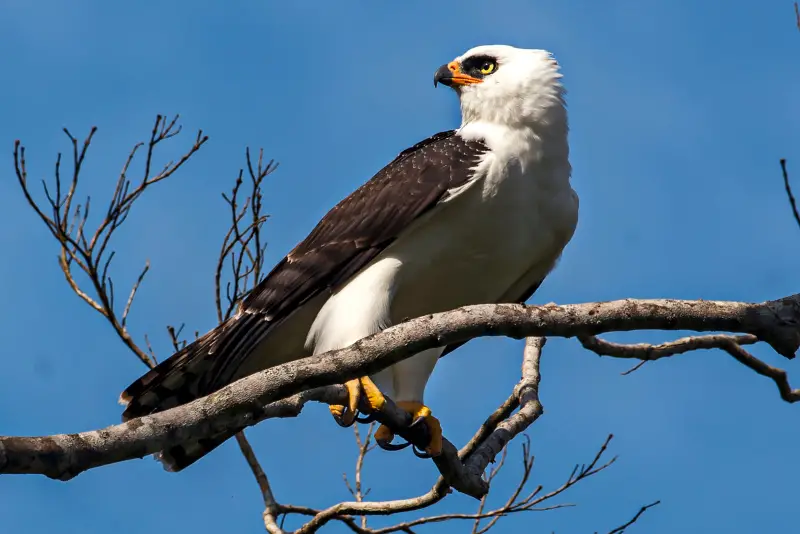
This impressive raptor is a bird of prey of the tropical lowland forests, and can be encountered in southern Mexico, Central America, and northern South America.
The Black-and-white Hawk-eagle has a largely white underside and head, while its back is uniformly black.
And while it is widespread across its range, it is uncommon everywhere, and is thus rarely observed.
When you do get to spot a Black-and-white Hawk-eagle, it’s usually circling slowly above a forest edge, while scanning the landscape below for unsuspecting prey caught in the open.
Final remarks
In summary, here are the 9 types of black and white hawks:
- Zone-tailed Hawk
- Common Black Hawk
- Harris’s Hawk
- Rough-legged Hawk (dark morph)
- Swainson’s Hawk (dark morph)
- Ferruginous Hawk (dark morph)
- Harlan’s Red-tailed Hawk
- Swallow-tailed Kite
- Osprey
- Black-and-white Hawk-eagle
If you’ve spotted one of these raptors while bird watching, but aren’t sure which species it was, check our detailed identification guide with photos above.
And if you enjoyed this article, check out our guide to the hawks in Florida.

